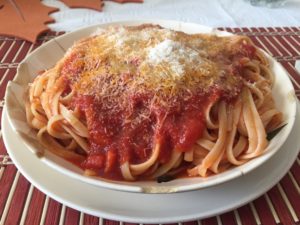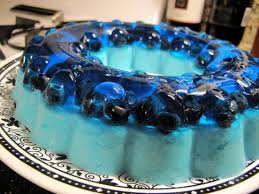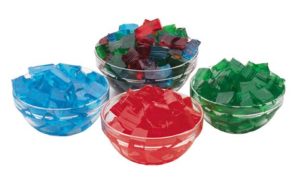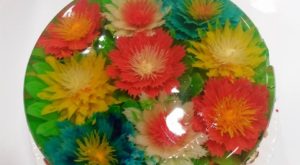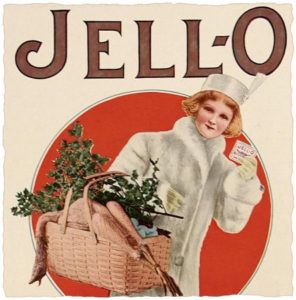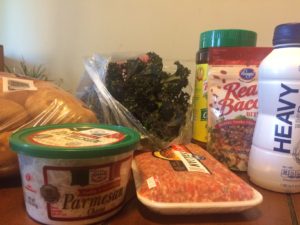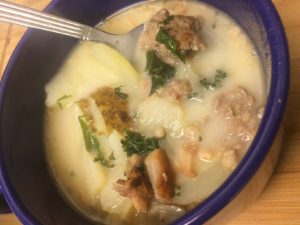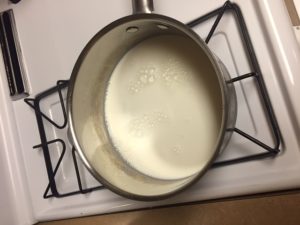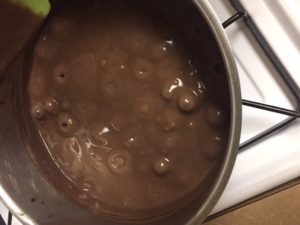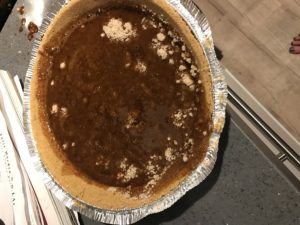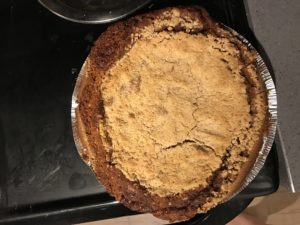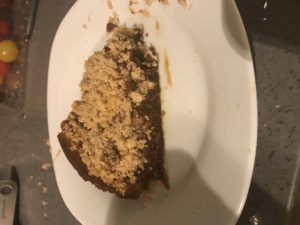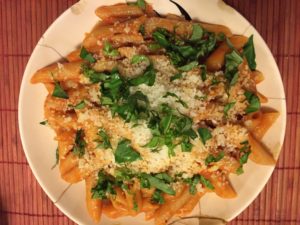Tacos Dorados de Papa
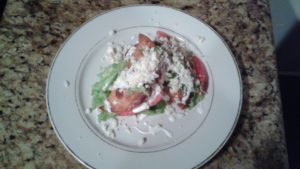
My mother use to make tacos dorados de papa (fried potato tacos) a lot for us when we were children. I remember that the people from church would always ask her to make them for the parish festival or for parish food sales. She would also change it up a bit and add chicken to the potatoes or make them of ground beef. She would roll them up and called them flautas (some people call them taquitos), but I found it easier just to fold the tortilla in half and make a quesadilla shape and not have to worry about or deal with the flauta coming undone. Some people put a toothpick to make them stick, but I think that looks disgusting, plus, taking it out is not that easy and biting into one is not fun. I just make my tacos dorados stick with the melted mozzarella cheese. Although the tacos are delicious, I try not to make them too often because, for some reason, I always manage to get myself burned. After making them for so many years, you’d think I’d have it thought out by now – go figure! Another subconscious reason I may not like making flautas is because when we were kids, my mom made ground beef flautas and they were just coming out of oil and had to cool down before we could eat them. Well, I’m guessing my older brother was quite hungry because he picked one up and was trying to cool it off by blowing into it and he blew a little too hard and the hot ground beef came flying in my face! Of course, I got burned by the hot meat and I was not at all amused. It was not a pretty moment for me, but my siblings had a great laugh and I also got a glimpse of my mother trying to hold back her laughter. Even though it was not a great experience for me, we are reminded about the incident when my mom makes flautas and now we just laugh about it. My family and coworkers are fond of my tacos which makes me feel good because I don’t cook too often, but when I do, it’s big and most of the time it’s good. Over the years, I have added toppings or different seasonings to my tacos, but it all started watching my mother make her delicious flautas. This is a meal she has passed down to me and a meal I can pass on to my children.

I would like to focus on one of the main ingredients – the potato. The potato is originally from the Andean mountain region in South America – the mountains are located on the western part from top to bottom. Spanish explorers discovered it and took it to Europe. Irish immigrants brought it to the United States in the 18th century, but large scale cultivation didn’t occur until the 19th century. Today, China, Russian Federation, Poland, India, and the United States are the main producers. Potatoes are grown commercially in 30 states, but Idaho grows much more than any other state. Although China is the top producer of potatoes in the world (95,987,500 tons), the United States is above many others in fifth place (19,843,900 tons). It is considered a healthy food only when you lay off the fattening toppings, and oil. I don’t think too many Americans eat the healthy version. Although Mexico is not on the map (at least not on the list of the top 25 countries) for being know to grow potatoes, flautas are said and known to be a Mexican dish.
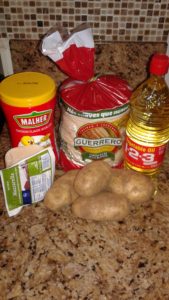
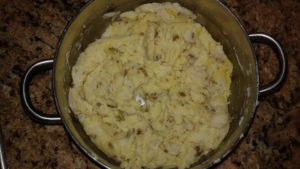
I present to you now, my recipe for making tacos dorados de papa. I usually make a big batch of about 30-40 and takes about an hour and a half. I begin by boiling the water for the potatoes. While the water is boiling, wash and scrub about 6 russet potatoes, stick a knife into them a couple times and then toss them in. While they are in the pot, heat up the oil in another pan and begin to crumble the cotija cheese or queso fresco and cut up the lettuce, tomatoes, and avocado into slices (or make guacamole). When the potatoes are soft, drain them (keep the skin on) and put in the mozzarella cheese (there really isn’t a ratio to the potatoes so you can use as much cheese as you like – I usually use a bit more than half of the 16oz bar or use it all if I won’t be using it for something else), mash them together into a paste (you can use the bean masher for this) and add seasoning (For this recipe, I use Malher or Maggi – Central American seasonings for chicken stew, but feel free to change it up and use what you like – salt and pepper will also work). There are recipes where the tortillas are warmed by putting them in the microwave – that’s a no no, tortillas should be warmed on a comal (flat griddle) and then the potato paste is put on one side of the tortilla, folded in half and in they go into the hot oil. Caution: Please remember that the oil has to be hot, otherwise, the taco gets soggy and will not cook very well. Also, don’t throw the tacos into the oil – you will get burned! Use the spatula to slide them into the oil. Have a plate ready with a couple paper towels over it and when the tacos are a golden-brown color on both sides, take them out and let any excess oil run off. Once they have cooled, they are ready to eat with the desired toppings. I recommend that you eat them while they are warm, otherwise they don’t taste too great. The good thing about tacos de papa is that you can reheat them on the comal or toaster oven.

My salsa verde is usually done in advance, because I make big batches and freeze the excess in Ziploc bags. Although this is a recipe for tacos dorados, I will throw in my recipe for the salsa that is drizzled on top of the tacos. This is super easy and ANYONE can do it – takes about 10 minutes on high heat. Before giving you my recipe, I would like to tell you a bit about where salsa originated. The history of Salsa (combination of chilies, tomatoes or tomatillos and other spices) can be traced to the Aztecs, Mayans and Incas as far back as 3000 BC. It was first called salsa by the Spanish priest and missionary Alonso de Molina in 1571. I move on now to my salsa recipe. I make my salsa quite spicy, so if you’re not comfortable with the heat, use different chilies. Begin by boiling the water. While the water boils, peel and wash about 15-20 tomatillos, cut off the ends of 8-10 habanero chilies, and peel a whole garlic. Toss all that into the pot of boiling water and wait until everything is boiled. You can let it cool before draining to avoid any burning, and then put all the ingredients in the blender and add salt to taste.
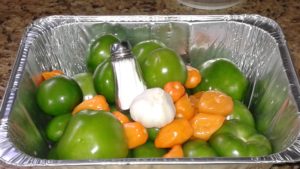
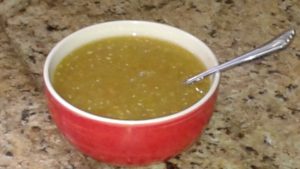
Although I always get burned some way or another from making these tacos dorados, I continue to make them because it reminds me of home, my childhood, and because they are very good – they’re a comfort food. If you are having a gathering, these tacos are a great meal – they are also inexpensive to make. If you are pressed for time on the day of, you can also prepare the tacos the day before and put them in the refrigerator and cook when you are ready.
Ingredients for the Tacos de Papa
Tortillas
Potatoes
Mozzarella Cheese
Vegetable Oil
Seasoning
Lettuce
Tomatoes
Sour Cream
Salsa
Avocado or Guacamole (optional)
Shredded Chicken, Ground Beef, or Ham (optional)
Grated or Fresh Cheese (optional)
Ingredients for Salsa Verde
Tomatillos
Habaneros Chilies
Garlic
Salt
References
Alena Bosse and Michael Boland, Kansas State University. Potato Profile. Revised April 2014 by Shannon Hoyle, AgMRC, Iowa State University AgMRC (Agriculture Marketing Center). http://www.agmrc.org/commodities-products/vegetables/potato-profile/. Accessed 15 Nov. 2016.
Food Editorial Co. The yummy food guide. http://www.streetdirectory.com/food_editorials/snacks/dips_and_sauces/history_of_salsa_sauce_the_mexican_connection.html. Accessed 19 Nov. 2016
Garcia, Edith. “Boiling Potatoes.” 2016. JPEG file.
Garcia, Edith. “Golden Brown Tacos Dorados.” 2016. JPEG file
Garcia, Edith. “Ingredients for Spicy Green Salsa.” 2016. JPEG file
Garcia, Edith. “Main Ingredients for Tacos de Papa.” 2016. JPEG file
Garcia, Edith. “Potato Paste.” 2016. JPEG file
Garcia, Edith. “Spicy Green Salsa.” 2016. JPEG file
Garcia, Edith. “Tacos Dorados de Papa.” 2016. JPEG file
Jackie@WifeLifeKitchen. Mexican Potato Tacos (Tacos de Papa). https://wifelifekitchen.com/?s=tacos+de+papa. Accessed 19 Nov. 2016
Potato Pro. Top 25 Potato Producing Countries
http://www.potatopro.com/world/potato-statistics. Accessed 15 Nov. 2016
SalsaShack.com. The History of Salsa Sauce. http://www.salsashack.com/History-Of-Salsa/. Accessed 19 Nov. 2016.
The World’s Healthiest Foods – Potatoes
http://www.whfoods.com/genpage.php?tname=foodspice&dbid=48. Accessed 15 Nov. 2016

